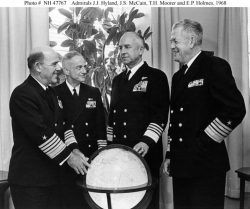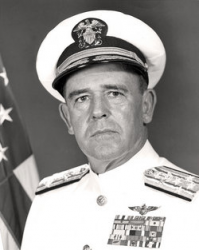
 |
|
|
||
|
John Joseph Hyland, Jr. |
||||
|
Graduate, U.S. Naval Academy, Class of 1934 Engagements: • World War II (1941 - 1945)• Vietnam War (1960 - 1973) |
||||
| Biography: | ||||
|
John Joseph Hyland, Jr. John Joseph Hyland Jr. was born on 1 September 1912 in Philadelphia, PA, the son of John Joseph Hyland, a Navy Captain. Young John graduated from the U.S. Naval Academy in the class of 1934; exactly 34 years after his father graduated from the Academy in the class of 1900. He was designated a Naval Aviator in 1937. In 1940, Hyland was stationed at Pearl Harbor and his family lived on Ford Island for six months. He was in the Philippines at the time of the Pearl Harbor attack and took part in the defense of the Philippines. He was in various engagements in the Dutch East Indies and the 1942 Allied pullback to Australia. Hyland won the Distinguished Flying Cross for ''extraordinary flying achievement'' and heroism in the rescue of a downed British flyer in the Molucca Sea in 1942. Later in 1942, he became Chief of Naval Operations Admiral Ernest J. King's personal pilot. He served as his pilot for 16 months before returning to the Pacific in 1943. Hyland's postwar career included a number of command positions, both sea and air; he also served in various high-ranking staff positions.. He did two stints as a Navy test pilot in the late 1940's and 1950's before taking command of the carrier USS Saratoga. In 1954, he returned to Hawaii to become Pacific Fleet Air Operations Officer. Just before assuming duties at the Strategic Plans Division in Washington, Rear Admiral Hyland served as Commander, Carrier Division Four from 8 November 1962 to 12 October 1963, aboard USS Forrestal in Norfolk VA. President Lyndon B. Johnson passed over 72 Rear Admirals that were senior to Hyland by promoting him to Vice Admiral and naming him Commander of the Seventh Fleet at the end of 1965. The choice reflected Admiral Hyland's extensive experience with carrier-based aerial combat and the President's campaign to bomb North Vietnam into submission. The Seventh Fleet was heavily involved in providing cover and support for American ground troops in the Vietnam War. To sap Vietcong supply lines, in 1967 the fleet mined North Vietnamese rivers from the air and shelled roads in North Vietnam from cruisers and destroyers located just offshore. On 30 November 1967, Hyland relieved Admiral Roy L. Johnson as Commander-in-Chief of the Pacific Fleet (CINCPACFLT), in Honolulu, during a ceremony on board the USS Kitty Hawk. Hyland also received a Distinguished Service Medal for his outstanding leadership of the Seventh Fleet. On 1 December 1967, Hyland's promotion to the four-star rank of Admiral became effective. Admiral Hyland retired from the Navy on 1 January 1971. Medals and Awards Navy Distinguished Service Medal (2 Awards) Honors Received the John Paul Jones Award for inspirational leadership from the Navy League in 1966. Inducted into the Naval Aviation Hall of Honor in Pensacola, FL. Inducted into the Naval Aviation Test Pilots Hall of Honor in Charleston, SC. In Retirement After retiring from the Navy, Hyland held business directorships and continued an active interest in naval aviation. Personal Hyland was married to Florence Day Whiting, who died in 1990 after 53 years of marriage. An art admirer, she was a volunteer with the Honolulu Academy of Arts. They had four children; two sons and two daughters. Death and Burial |
||||
| Honoree ID: 561 | Created by: MHOH | |||
Ribbons
Medals
Badges
Honoree Photos
 |  |  |
 |  |
 |


